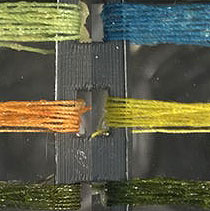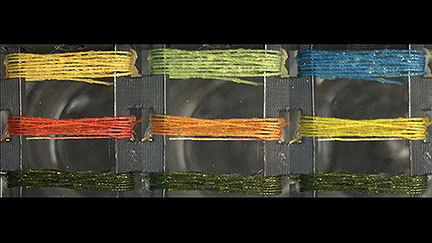Thread-Based Sensors Detect Toxic Gas
 Apr-04-19
Gas-sensitive, color-changing threads sewn into clothing could be used to create textile-based detectors for health and safety workers.
Apr-04-19
Gas-sensitive, color-changing threads sewn into clothing could be used to create textile-based detectors for health and safety workers.Developed by a team from Tufts University, the color-changing threads consist of regular thread that has been infused with one of three types of dye. The MnTpp and bromothymol blue dyes react to ammonia, while the third—methyl red—reacts to hydrogen chloride. The threads were first treated with acetic acid to encourage the dye to bond with the fibers, and then finally coated with the organic polymer PDMS to create a water-repellent, gas-permeable seal.
The threads will respond to gas concentrations as low as 50 parts per million, even underwater, with a color change detectable by the human eye, though a smartphone and app could offer more detailed information. The fabric can also be washed and reused many times without degrading the thread-based sensors.
Image Sensing threads prepared with bromothymol blue (top thread), methyl red (middle thread) and MnTPP (bottom thread) are exposed to ammonia at 0 ppm (left panel) 50 ppm (middle panel) and 1000 ppm (right panel)

More Info about this Invention:
[NATURE.COM][NOW.TUFTS.EDU]

Add Your Comment